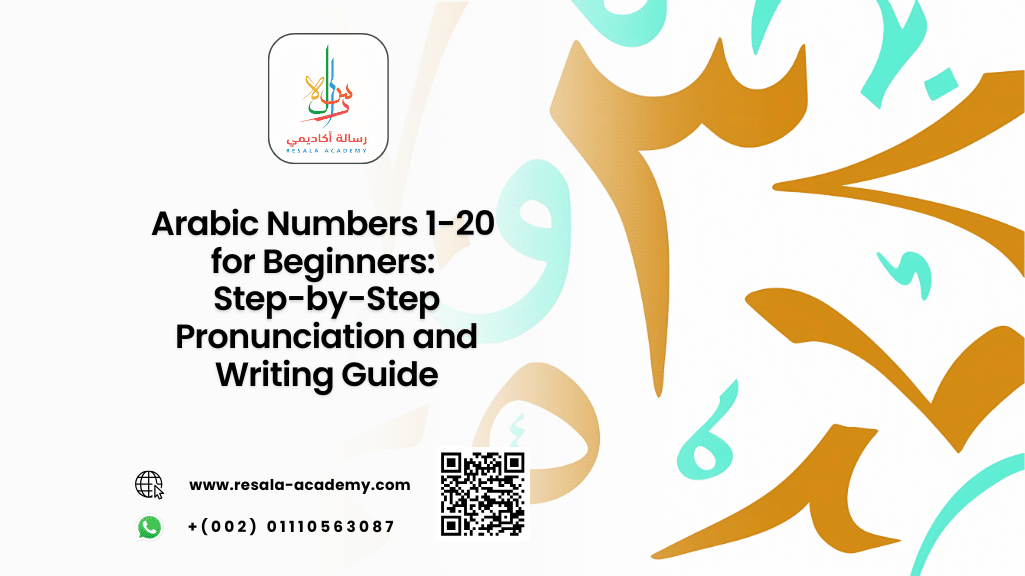Table of Contents
Arabic Numbers 1-20 for Beginners: Step-by-Step Pronunciation and Writing Guide
Learning the Arabic Numbers 1-20 is an essential step for any non-native speaker beginning their journey into the Arabic language.
Whether you’re traveling to an Arabic-speaking country, studying the Quran, or simply expanding your linguistic horizons, mastering numbers is a foundational skill. In this comprehensive guide, we’ll walk you through the pronunciation, writing, and usage of Arabic numbers from 1 to 20 — all tailored for beginners.
This guide is brought to you in collaboration with Resala Academy, a leading online platform offering Arabic classes for non-native speakers. Let’s dive into the world of Arabic numerals and unlock the first step to fluency.
Why Learn Arabic Numbers 1-20?
Understanding Arabic numerals is more than just memorizing digits. These numbers are used in daily communication, from telling time and counting money to giving directions and understanding dates. Learning the Arabic Numbers 1-20 will:
- Build your confidence in basic conversations
- Help you understand Arabic grammar structures
- Enhance your ability to read and write Arabic
- Prepare you for more advanced vocabulary and sentence construction
Overview of Arabic Numerals
Arabic numbers are written from left to right (just like English), but the Arabic script itself is written from right to left. The modern numerals used globally (0-9) are derived from Arabic numerals, but in Arabic script, they appear differently.
| English Number | Arabic Numeral | Arabic Word | Transliteration |
|---|---|---|---|
| 1 | ١ | واحد | wāḥid |
| 2 | ٢ | اثنان | ithnān |
| 3 | ٣ | ثلاثة | thalātha |
| 4 | ٤ | أربعة | arba‘a |
| 5 | ٥ | خمسة | khamsa |
| 6 | ٦ | ستة | sitta |
| 7 | ٧ | سبعة | sab‘a |
| 8 | ٨ | ثمانية | thamāniya |
| 9 | ٩ | تسعة | tis‘a |
| 10 | ١٠ | عشرة | ‘ashara |
| 11 | ١١ | أحد عشر | aḥada ‘ashar |
| 12 | ١٢ | اثنا عشر | ithnā ‘ashar |
| 13 | ١٣ | ثلاثة عشر | thalāthata ‘ashar |
| 14 | ١٤ | أربعة عشر | arba‘ata ‘ashar |
| 15 | ١٥ | خمسة عشر | khamsata ‘ashar |
| 16 | ١٦ | ستة عشر | sittata ‘ashar |
| 17 | ١٧ | سبعة عشر | sab‘ata ‘ashar |
| 18 | ١٨ | ثمانية عشر | thamāniyata ‘ashar |
| 19 | ١٩ | تسعة عشر | tis‘ata ‘ashar |
| 20 | ٢٠ | عشرون | ‘ishrūn |
Step-by-Step Pronunciation Guide
Numbers 1-10
These are the most commonly used numbers in daily conversations.
- 1 – واحد (wāḥid): Pronounced “wah-hed”
- 2 – اثنان (ithnān): Pronounced “ith-naan”
- 3 – ثلاثة (thalātha): Pronounced “tha-la-tha”
- 4 – أربعة (arba‘a): Pronounced “ar-ba-a”
- 5 – خمسة (khamsa): Pronounced “kham-sa”
- 6 – ستة (sitta): Pronounced “sit-ta”
- 7 – سبعة (sab‘a): Pronounced “sab-a”
- 8 – ثمانية (thamāniya): Pronounced “tha-ma-ni-ya”
- 9 – تسعة (tis‘a): Pronounced “tis-a”
- 10 – عشرة (‘ashara): Pronounced “a-sha-ra”
Numbers 11-20
These numbers are compound forms, combining units with “ten”.
- 11 – أحد عشر (aḥada ‘ashar): “a-ha-da a-sha-ra”
- 12 – اثنا عشر (ithnā ‘ashar): “ith-na a-sha-ra”
- 13 – ثلاثة عشر (thalāthata ‘ashar): “tha-la-tha-ta a-sha-ra”
- 14 – أربعة عشر (arba‘ata ‘ashar): “ar-ba-a-ta a-sha-ra”
- 15 – خمسة عشر (khamsata ‘ashar): “kham-sa-ta a-sha-ra”
- 16 – ستة عشر (sittata ‘ashar): “sit-ta-ta a-sha-ra”
- 17 – سبعة عشر (sab‘ata ‘ashar): “sab-a-ta a-sha-ra”
- 18 – ثمانية عشر (thamāniyata ‘ashar): “tha-ma-ni-ya-ta a-sha-ra”
- 19 – تسعة عشر (tis‘ata ‘ashar): “tis-a-ta a-sha-ra”
- 20 – عشرون (‘ishrūn): “ish-roon”
How to Write Numbers 1 to 20 in Arabic — Visual and Structural Insights
Understanding how to write numbers 1 to 20 in Arabic is a vital skill for learners aiming to read and write fluently. Unlike English, Arabic script flows from right to left, and its numerals have unique shapes that differ from the Western digits we use daily.
Below is a breakdown of essential points to help you master writing Arabic numbers 1-20 with clarity and confidence.
Arabic Numerals Are Unique Symbols
While the Western world uses 1, 2, 3, etc., Arabic numerals in script look entirely different. For example, the number 1 is written as “١”, and 2 as “٢”. These symbols are essential to recognize when reading Arabic texts.Right-to-Left Writing Direction
Arabic script, including its numbers, is written from right to left. This means when writing “12” in Arabic, you start with the number 1 (١) on the right and then add 2 (٢) to the left, forming “١٢”.Compound Numbers Have a Specific Structure
Numbers from 11 to 19 in Arabic are compound forms, combining the unit digit with the word for ten (“عشر”). For instance, 13 is written as “ثلاثة عشر” (thalāthata ‘ashar), blending the word for 3 (ثلاثة) with 10 (عشر).The Number 20 Has a Unique Form
Unlike the compound numbers, 20 is written as a standalone word: “عشرون” (‘ishrūn). It is not a combination of 2 and 10 but a distinct plural form of ten.Visual Practice Enhances Retention
Practicing the visual form of each numeral (١ to ٢٠) helps reinforce memory. Use tracing sheets or digital writing tools to get accustomed to the curves and strokes of each digit.Use of Diacritics in Numbers
While diacritics (short vowel marks) are optional in modern Arabic writing, they are often included in educational materials to aid pronunciation. For example, “ثلاثة” (three) may appear as “ثَلاثَة” in beginner texts.Consistency in Font and Style
Arabic fonts can vary, but the numeral shapes remain consistent across styles. Stick to beginner-friendly fonts like “Amiri” or “Traditional Arabic” when practicing.Arabic Numbers in Contextual Sentences
Writing numbers within sentences helps solidify understanding. For example:- Arabic: لدي خمسة أقلام
- English: I have five pens
- Number: ٥ (khamsa)
Interactive Writing Tools
Use online platforms like Resala Academy that offer interactive whiteboards and writing exercises to practice how to write numbers 1 to 20 in Arabic with real-time feedback.
Writing Arabic Numbers: Tips for Beginners
Arabic script is cursive, and numbers are written using distinct symbols. Here are some tips to help you write Arabic numbers correctly:
- Practice writing from right to left.
- Use lined paper to maintain consistency in size and alignment.
- Focus on the shape of each numeral; many look similar but have subtle differences.
- Use flashcards to reinforce memory.
Ready to write Arabic with confidence? Discover powerful “Arabic Writing Practice” routines designed to accelerate fluency for non-native learners—start mastering the script today!
Practical Applications of Arabic Numbers 1-20 in Everyday Life
Beyond memorization, applying Arabic numbers 1-20 in real-life scenarios accelerates fluency and builds confidence. Here’s how these numbers play a role in daily interactions and learning environments.
Time Telling and Scheduling
Numbers are crucial when reading clocks or setting appointments. For instance, “الساعة الثانية” means “two o’clock”, using the number 2 (٢).Currency and Shopping
When shopping in Arabic-speaking countries, numbers like “١٠” (ten) or “١٥” (fifteen) are frequently seen on price tags and receipts. Understanding these helps avoid confusion and ensures accurate transactions.Phone Numbers and Addresses
Reading and writing phone numbers or addresses in Arabic requires familiarity with the numerals. For example, a phone number like 123456 becomes “١٢٣٤٥٦”.Classroom Learning and Exams
In educational settings, students often encounter questions like “اكتب الأرقام من ١ إلى ٢٠” (Write the numbers from 1 to 20). Knowing how to write Arabic numbers correctly is essential for academic success.Religious and Cultural Contexts
Arabic numbers are used in Quranic verses, Hadith references, and Islamic dates. For example, “الآية ١٨” refers to verse 18, using the number ١٨ (eighteen).Games and Sports
Scores in sports or board games often use Arabic numerals. Recognizing numbers like “٧” (seven) or “١٣” (thirteen) adds to the enjoyment and understanding of the activity.Travel and Navigation
Street signs, bus numbers, and hotel room numbers are often in Arabic numerals. Knowing how to read “١٢” (twelve) or “٢٠” (twenty) is vital for smooth travel experiences.Digital Interfaces and Devices
Mobile phones, ATMs, and public kiosks in Arabic-speaking countries display numbers in Arabic script. Familiarity with these symbols ensures seamless interaction with technology.Social Media and Messaging
Arabic speakers often use native numerals in texts and posts. Understanding “١٠٠٪” (100%) or “١٥ دقيقة” (15 minutes) helps you engage more authentically online.Building Vocabulary Through Numbers
Each number is tied to a broader set of vocabulary. For example, learning “خمسة” (five) can lead to learning “خمسة أيام” (five days), expanding your word bank naturally.
These detailed insights not only help you understand how to write numbers 1 to 20 in Arabic but also show their importance in practical, real-world contexts. For a structured, immersive learning experience, explore the interactive lessons at Resala Academy and take your Arabic skills to the next level.
Real-Life Examples Using Arabic Numbers 1-20
Here are some practical examples of how these numbers are used in everyday Arabic:
I have three books.
Arabic: لدي ثلاثة كتب
Transliteration: ladayya thalātha kutubShe bought five apples.
Arabic: اشترت خمس تفاحات
Transliteration: ishtarat khams tuffāḥātThe class starts at ten o’clock.
Arabic: يبدأ الدرس في الساعة العاشرة
Transliteration: yabda’ al-dars fī al-sā‘a al-‘āshiraHe has twelve pens.
Arabic: لديه اثنا عشر قلماً
Transliteration: ladayhi ithnā ‘ashar qalamānWe are twenty students.
Arabic: نحن عشرون طالبًا
Transliteration: naḥnu ‘ishrūn ṭāliban
How to Memorize Arabic Numbers Easily
Here are some effective techniques to help you memorize Arabic numbers from 1 to 20:
- Use Mnemonics: Associate each number with an image or story.
- Flashcards: Create cards with Arabic on one side and English on the other.
- Daily Practice: Use numbers in your daily routine — count steps, objects, or time.
- Language Apps: Use apps like Duolingo or Memrise with Arabic modules.
- Enroll in a Course: Join an online structured program like the Intensive Arabic Course Online at Resala Academy for guided learning.
Learn Arabic Numbers and More with Resala Academy
If you’re serious about mastering Arabic — from numbers to grammar and conversation — there’s no better place to start than Resala Academy. As a premier online learning platform, Resala Academy offers:
✅ Live classes with native Arabic instructors
✅ Courses tailored for non-native speakers
✅ Flexible schedules for busy learners
✅ Interactive lessons with real-life applications
✅ A supportive learning community
Ready to take your Arabic skills to the next level?
👉 Join Resala Academy today and start speaking Arabic with confidence!
Frequently Asked Questions (FAQs)
1. Why should I learn Arabic numbers 1-20 first?
Learning the first 20 numbers provides a strong foundation for understanding dates, time, money, and basic conversation in Arabic. It’s an essential step for beginners.
2. Are Arabic numbers the same across all Arabic-speaking countries?
Yes, the numbers 1-20 are consistent across all Arabic dialects, although pronunciation may slightly vary. The written form remains the same.
3. How long does it take to memorize Arabic numbers 1-20?
With daily practice, most learners can memorize these numbers within a week. Using tools like flashcards and repetition can speed up the process.
4. Can I learn Arabic numbers without knowing the Arabic alphabet?
Yes, you can learn to recognize and pronounce numbers without mastering the full alphabet, but learning the script will enhance your reading and writing skills.
5. Where can I find structured Arabic lessons for beginners?
Resala Academy offers beginner-friendly Arabic courses, including lessons on numbers, grammar, vocabulary, and conversation.
Conclusion
Mastering the Arabic Numbers 1-20 is a crucial step for any Arabic language learner. With the right guidance, tools, and practice, you can quickly become comfortable using these numbers in both written and spoken Arabic.
Whether you’re learning for travel, religion, or personal growth, numbers are your gateway to deeper understanding. Don’t forget — the journey to fluency begins with a single step. Let that step be learning your first twenty numbers in Arabic.
Start your Arabic journey today with Resala Academy — where language meets culture, and learning becomes a lifelong passion.




